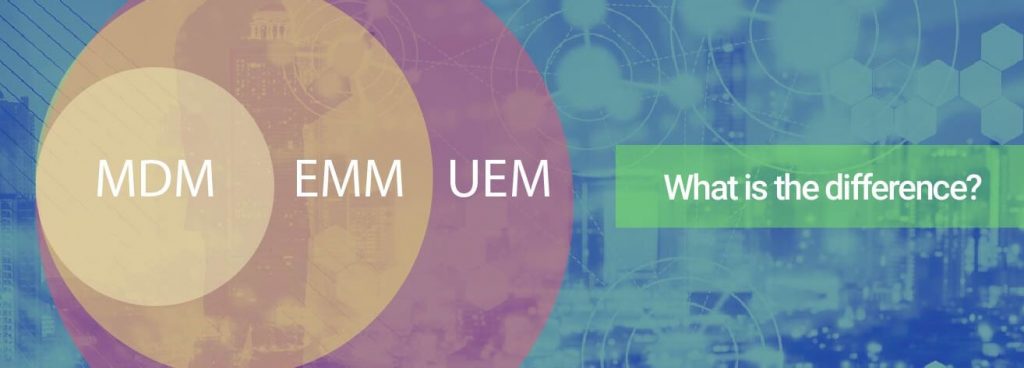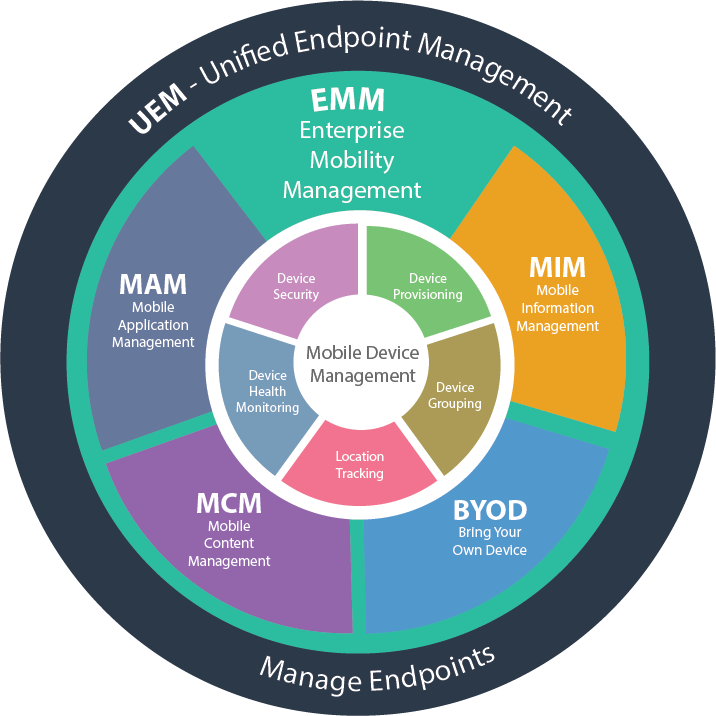What is the Difference Between MDM, EMM, and UEM?
Abr 24, 2017 | 42Gears Team

Managing mobile devices across business operations is more critical to enterprise success than ever before. Several categories of mobile security products like MDM (Mobile Device Management) and EMM (Enterprise Mobility Management) have emerged to address the problems related to data security and privacy. Here are few pointers which will explain the basic difference between these products:
MDM (Mobile Device Management)
Is all about remotely managing devices, allowing users to perform certain prescribed tasks on their phones and tablets. MDM includes features like device provisioning, enrollment, device security and location tracking. It also helps in wiping the data in case the device is stolen or lost. A basic MDM tool has the ability to enforce security policies, track inventory and perform real-time monitoring and reporting.
From a security standpoint, this was a perfectly reasonable way to manage a company-owned device. But some employees were not very comfortable carrying two separate devices for business and personal use. So It was in the interest of businesses to consider employees’ demand for BYOD (Bring Your Own Device). A single device which gave employees the flexibility and ease to shift from personal to work use, anywhere, and anytime.
The rapid growth of the smartphones, mobile applications market, and the need for data security led to the creation of Mobile Application Management (MAM) solution that limited the management and control of specific business applications. Mobile Application Management is like MDM, except that it’s only applied to specific applications on a device instead of the entire device. MAM helps in creating an enterprise app store and pushing or updating necessary apps on business devices remotely. But sometimes MAM has its own set of challenges as well. Since every business app requires unique coding to work with each individual MAM product, the availability of apps for a specific standalone platform can be limited.
Nonetheless, MAM was a perfect settlement between employees and employers without compromising data security and interfering in employee privacy. But in practice, the experience was not so great as it cannot be easily extended to support the majority of native app-store applications. After that, there were several small development stages where the experience got redefined with the evolution of applications such as MIM (Mobile Information Management) and MCM (Mobile Content Management). They are focused on the security of a particular document repository where employees and employers access and share documents or files without affecting the entire device or other applications.
EMM (Enterprise Mobility Management)
And finally, it reached the stage of EMM). EMM is nothing more than the combination of an MDM and MAM solutions equipped with a secure container that keeps business data secure. An EMM solution in addition to MDM offers Mobile App Management, Mobile Content Management, App Wrapping and Containerization. EMM is a complete package of services which offers complete data security on BYOD and Dedicated Devices (formerly called COSU or Corporate-Owned Single-Use) for enterprises.
While MAM and MDM solutions were going through continuous upgradations to match the growing needs of data security in enterprises, BYOD as a concept came into picture which allowed the end users to bring in their own mobile devices and get them enrolled into IT’s corporate resources. BYOD is enabled through the concept of containerization, letting the IT Admin segregate company and personal data on the same handheld. It helps the IT Admin create encrypted, policy-enabled and distinct containers in employee’s personal devices to use browser apps and deliver specific email and data.
Simply put, the main difference between MDM and EMM is that MDM manages all the features of the device while EMM manages the entire device. EMM provides policy compliance, app customization, data and document security and incorporates into the network directory services.
UEM (Unified Endpoint Management)
As more enterprises become aware of the need to safeguard their networks and ensure data compliance, they are quickly switching from MDM to EMM solutions. As new progressive technologies make their way into the global market, the world is moving towards advanced mobility management solutions such as Unified Endpoint Management (UEM). UEM enables businesses to manage all endpoints such as laptops, mobile phones, tablets, PCs, printers, and wearables using a single comprehensive EMM solution.
Looking for the right platform to manage
all your business devices?
Subscribe for our free newsletter







